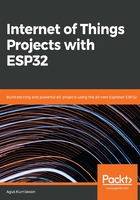
What this book covers
Chapter 1, Getting Started with ESP32, presents a review of the ESP32 board. We also set up a development environment for ESP32 boards.
Chapter 2, Making Visual Data and Animation on an LCD, offers a brief introduction to weather systems. Here, we'll make a simple ESP32 program to sense temperature and humidity using the DHT22 sensor module. Furthermore, we'll work with the LCD on the ESP32 board, accessing the LCD modules through the ESP32 board.
Chapter 3, Building a Simple Game with an Embedded ESP32 Board, teaches you how to work with an analog joystick, along with an exploration of a simple sound device with a sound buzzer, and the development of a simple game.
Chapter 4, Building a Sensor Monitoring Logger, covers how to work with external storage, such as SD cards and microSD cards, on an ESP32 board. We'll store our sensor data on external storage, and use a sensor monitoring logger by applying sleep mode after sensing and storing sensor data.
Chapter 5, Controlling IoT Devices over the Internet, covers how to work with Wi-Fi on an ESP32 board. Our ESP32 board will be connected to the internet and accessed over a web server. We'll also make a simple web server inside the ESP32 board. Lastly, we'll build a simple smart home device by controlling an LED over a network.
Chapter 6, Building an IoT Weather Station, takes the reader through building a weather station with ESP32 and DHT22. We'll also extend our weather station with Node.js in order to serve massive requests.
Chapter 7, Making Your Own Wi-Fi Wardriving, teaches the reader how to access the GPS module on the ESP32 board. We'll build a simple wardriving project to perform Wi-Fi profiling on a GPS location. We'll see how to read Wi-Fi SSIDs and GPS data simultaneously.
Chapter 8, Building Your Own Wi-Fi Cam, outlines how to work with the camera module on the ESP32 board. Here, we'll use the OV7670 camera module to capture images. We'll also develop Wi-Fi functionality to take a picture over a network.
Chapter 9, Making IoT Devices Interact with Mobile Applications, outlines how to develop an ESP32 program and an Android application, and then make the two interact using the Wi-Fi protocol as a communication medium. You can use this approach to control some sensor and actuator devices on the ESP32 board via an Android application. We'll learn how to build a BLE service on the ESP32 board, and cover how to make interactions between the ESP32 board and mobile Android through BLE.
Chapter 10, Building IoT Monitoring with Cloud Technology, covers operations in AWS IoT. We'll create an ESP32 program to send temperature and humidity sensor data to AWS IoT, and build a communication link between AWS IoT and ESP32 over MQTT. This skill can be extended to other IoT devices.